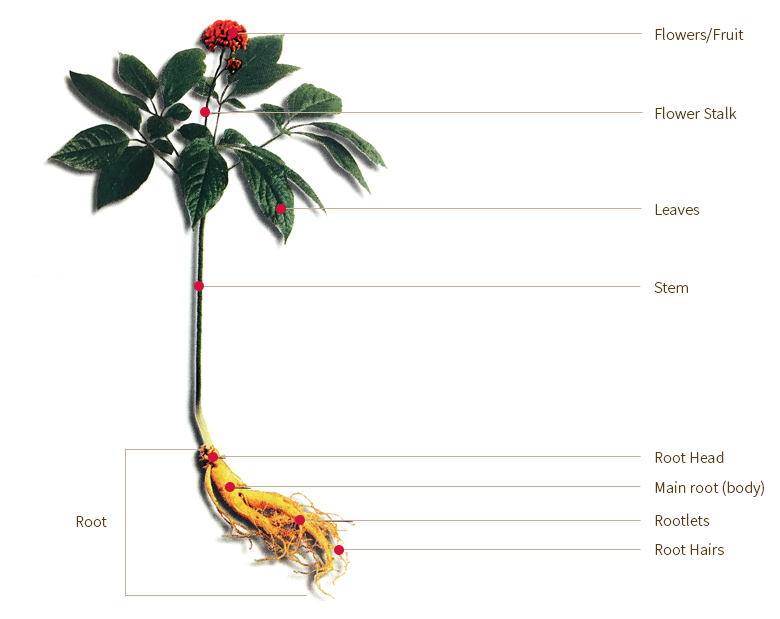Geumsan story
Ginseng is heavily affected by its growing environment, geographical conditions and collecting period, and Geumsan has natural advantage for cultivating ginseng, with a large daily temperature range. Geumsan ginseng is small, but hard and white in color, compared to ginseng from other areas. Geumsan ginseng that has 1500 years of history, are called summer ginseng as they are collected from beginning of July until end of October where its pharmacological action is at its highest level. Compared to ginseng from other areas, Geumsan ginseng (summer ginseng) contains 5.2% more saponin, which is the main ingredient of ginseng.
Ginseng Shapes and Uses for Each Part
The flowers begin to bloom in the third year of growth.
The fruit is green at first, but as it ripens it turns red. It is often called the “daughter of ginseng”, and is generally used after being picked and dried.
The leaves have long leafstalks and are separated into five sections, with several small leaves clustered together in the shape of a hand. The end of the leaf is pointed, and the edge has a thin sawtooth shape.
This is the portion which is generally called ginseng. It is widely used for medicine and food.
The ginseng plant is a perennial. Each year the stalk and leaves dry up and die, and each time this leaves a mark on the root head. In the case of fresh ginseng, roots with large heads are more expensive, and Korean ginseng is notable for having a larger root head than ginseng from other countries.
The middle part of the ginseng root, which is processed in a variety of ways for use in medicine or food
Ginseng usually has 2-5 rootlets. The number of rootlets differs according to factors like soil quality, method of cultivation, and age.
When separated this portion is referred to as “misam”, and is used in ginseng tea, etc.
Different types of ginseng
Classification according to its growing environment
Artificially grown ginseng at ginseng farm. Geumsan is the biggest producer at district level.
Artificially grown ginseng from wild ginseng seed in the natural forest.
Wildly grown ginseng in natural conditions of deep forest.
Classification according to areas of production
It has strong aroma/scent and great medicinal effect as it is cultivated for 180 days, which is longer cultivation period, compared to ginseng from other countries (120 – 130 days)
Ginseng produced in United States and Canada that has similar roots to Korean ginseng, but its body is not smooth, with short rootlets and horizontal lines like skein.
Grown mostly in areas from Northeast of China’s Yunnan province to Southwest of Guangxi province. Root is a taproot type and is bumpy and black in color. It is 3-4 cm long and has a shape of a sunchoke.
Japanese seng has a shape of bamboo roots and hardly has any medicinal effect. It is widely distributed in Japanese islands, including Southern Hokkaido and Northern Kyushu, China’s Zhejiang Province, Hunan Province, Guizhou Province, Yunnan Province and Midwestern Sichuan Province, as well as Northern India and Nepal.
Classification according to processing procedures
Original from of 4-6 year old ginseng, straight from the ground. It is good to eat it raw, since it contains all the unique properties of ginseng. It is also consumed as beverages by blending it with honey or milk, as well as using it as ingredients for various dishes.
It is processed to have water contents under 14%, using 4-6-year-old raw ginseng as base material, with its skin is slightly peeled off and sun dried, but its original form is preserved. Long term storage is possible and it is mainly used in medicine and tea.
- Straight ginseng : Dried body part of ginseng, without bending it.
- Half- curved ginseng : Dried body part of ginseng, which is bent a half way.
- Curved ginseng : Dried body part of ginseng, which is completely bent in a circle shape.
- Fine roots : Dried rootlets, trimmed from ginseng
Reddish brown product, made by steaming and drying raw ginseng. It can be divided into Heaven grade ginseng, Earth grade ginseng and Good grade ginseng according to its quality and can be stored for a long time. There is no trouble for people who shows allergic reaction to ginseng, consumes red ginseng and it is proven to have great responsiveness to various diseases, especially to AIDS and dioxin. It is good to consume it in various forms, such as extract, powder, capsules ad tea for a long term.
This product is halfway between white ginseng and red ginseng, where the raw ginseng’s part of the body is gelatinized from its outer layer by submerging it in hot water for a certain period of time, and then dried afterward. Its color and effect are very similar to red ginseng.
